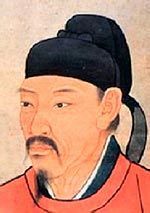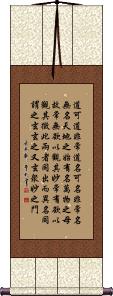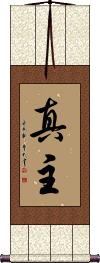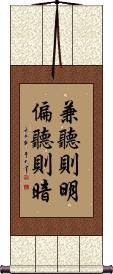Many custom options...
And formats...

Appear in Chinese / Japanese...
Buy an Appear calligraphy wall scroll here!
Personalize your custom “Appear” project by clicking the button next to your favorite “Appear” title below...
Daodejing / Tao Te Ching - Chapter 1
This text is the first chapter of the Daodejing / Tao Te Ching.
The text reads:
道可道、非常道。名可名、非常名。 無名天地之始 有名萬物之母。故常無欲以觀其妙、常有欲以觀其徼。此兩者同出而異名。同謂之玄。玄之又玄、衆妙之門。
This classical Chinese passage comes from the Mawangdui (馬王堆帛書) text.
The Way that can be followed is not the eternal Way.
The name that can be named is not the eternal name.
The nameless is the origin of heaven and earth
While naming is the origin of a myriad of things.
Therefore, always desireless, you see the mystery
Ever desiring, you see the manifestations.
These two are the same—
When they appear they are named differently.
This sameness is the mystery,
Mystery within mystery;
The door to all marvels.
Dr. Muller's translation of all 81 Daodejing chapters
Allah / God of Islam
真主 is how Chinese Muslims refer to God (it literally means “True Master”).
Oddly, in China, two different names for God have emerged. Even though Muslims, Christians, and Jews all worship the same God of Abraham.
In Arabic, the word Allah is just the Arabic way to say, God. Arab Christians pray to Allah, just like Arab Muslims. Somehow in China, the title of God diverged.
If you are curious, there are millions of Muslims throughout China but especially in the northwest portion of China known as Xinjiang. Here you will find descendants of Turkmen, Persian, Arab, and other ethnicities. Some are mixed with Han-Chinese blood; others appear to be pure Turkmen. Many have fair complexions, green eyes, and light hair but all are citizens of China. A visit to Xinjiang will shift your paradigm and blow away all of your stereotypes about what it means to be Chinese.
Not Only Can Water Float A Boat, It Can Sink It Also
Many things have opposite properties. The water you drink can also drown you. Pork may nourish you and keep you alive but under-cook it and it could kill you. Potassium nitrate is often used as a fertilizer to grow the food that sustains us but it's also been used as an explosive to topple buildings and destroy us.
This concept is easily associated with “yin yang” where an element has two opposite properties that are as different as night and day.
This proverb's meaning can be summed up this way: “Anything that can lead you to success may also contain great risks.”
This phrase is known in literary circles by Korean people (scholars or literature). It is therefore also a valid proverb in Korean Hanja, though most Koreans would not be able to make sense of it.
Please note that there is an unwritten rule when the same character appears twice in the same phrase, the calligrapher will alter the appearance so that no two characters are exactly alike in the same piece. This calligraphy has two repeating characters that will be written differently than they appear here.
Listen to Both Sides and be Enlightened, Listen to One Side and be in the Dark
兼聽則明偏聽則暗 is an ancient Chinese proverb about getting all the information from all sides so that you truly understand a situation.

Wei Zheng
A man named Wei Zheng lived between 580-643 AD. He was a noble and wise historian and minister in the court of the early Tang Dynasty. The emperor once asked him, “What should an emperor do to understand the real-world situation, and what makes an emperor out-of-touch with reality?”
Wei Zheng replied, “Listen to both sides and you will be enlightened; listen to only one side and you will be left in the dark.”
Then Wei Zheng went on to cite examples of leaders in history that were victorious after heeding both sides of the story, and other leaders that met their doom because they believed one-sided stories which often came from flattering lips.
Please note that there is an unwritten rule when the same character appears twice in the same phrase, the calligrapher will alter the appearance so that no two characters are exactly alike in the same piece. This calligraphy has two repeating characters that will be written differently than they appear here.
These search terms might be related to Appear:
Even the 100-Foot Bamboo Can Grow One More Foot
Hold Hands With You, Grow Old With You
If You Cannot Bite, Do Not Show Your Teeth
Plant / Grow / Cultivate
To Come / to Arrive
Not the results for appear that you were looking for?
Below are some entries from our dictionary that may match your appear search...
| Characters If shown, 2nd row is Simp. Chinese |
Pronunciation Romanization |
Simple Dictionary Definition |
似 see styles |
sì si4 ssu ni に |
to seem; to appear; to resemble; similar; -like; pseudo-; (more) than (suffix) looking like (someone); taking after (either of one's parents); (female given name) Ayu Appearance of, seeming as, like, as; than. |
僾 see styles |
ài ai4 ai |
indistinct; hazy; misty; to seem; to appear |
形 see styles |
xíng xing2 hsing kei / ke けい |
to appear; to look; form; shape (suffix) (1) (See 活用形・かつようけい,三角形・さんかくけい) form; tense; (2) (abbreviation) {gramm} (part of speech tag used in dictionaries) (See 形容詞) adjective; i-adjective (in Japanese); (surname) Kata Form, figure, appearance, the body. |
晛 𬀪 see styles |
xiàn xian4 hsien |
to appear (of sun) |
現 现 see styles |
xiàn xian4 hsien gen げん |
to appear; present; now; existing; current (prefix) present (e.g. government, administration); current; existing; (personal name) Yukitoshi Appear, apparent; manifest, visible; now; present; ready. |
瞥 see styles |
piē pie1 p`ieh pieh minetoshi みねとし |
to shoot a glance; glance; to appear in a flash (personal name) Minetoshi A glance. |
見 见 see styles |
xiàn xian4 hsien mi み |
to appear; also written 現|现[xian4] (n-suf,n) (1) looking; viewing; (expression) (2) (colloquialism) (kana only) (after the -te form of a verb; irreg. imperative conj. of 見る) (See 見る・5) (please) try (to); (female given name) Miru darśana, 捺喇捨曩; also dṛṣṭi; seeing, discerning, judgment, views, opinions; it is thinking, reasoning, discriminating, selecting truth, including the whole process of deducing conclusions from premises. It is commonly used in the sense of wrong or heterodox views or theories, i. e. 邪見 or 有見, especially such as viewing the seeming as real and the ego as real. There are groups of two, four, five, seven, ten and sixty-two kinds of 見. |
起 see styles |
qǐ qi3 ch`i chi hajime はじめ |
to rise; to raise; to get up; to set out; to start; to appear; to launch; to initiate (action); to draft; to establish; to get (from a depot or counter); verb suffix, to start; starting from (a time, place, price etc); classifier for occurrences or unpredictable events: case, instance; classifier for groups: batch, group (irregular okurigana usage) source; origin; cause; beginning; genesis; (female given name) Hajime To rise, raise, start, begin; uprising; tr. utpada. |
透 see styles |
tòu tou4 t`ou tou yuki ゆき |
(bound form) to penetrate; to seep through; to tell secretly; to leak; thoroughly; through and through; to appear; to show (female given name) Yuki to permeate |
ぐむ see styles |
gumu ぐむ |
(suf,v5m) (after a noun) (See 芽ぐむ,涙ぐむ) to appear; to start to appear; to show signs of appearing; (place-name) Qum (Iran) |
三身 see styles |
sān shēn san1 shen1 san shen sanjin; sanshin さんじん; さんしん |
{Buddh} trikaya (three bodies of the Buddha); (surname) Sanmi trikāya. 三寶身 The threefold body or nature of a Buddha, i.e. the 法, 報, and 化身, or dharmakāya, sambhogakāya, and nirmāṇakāya. The three are defined as 自性, 受用, and 變化, the Buddha-body per se, or in its essential nature; his body of bliss, which he "receives" for his own "use" and enjoyment; and his body of transformation, by which he can appear in any form; i.e. spiritual, or essential; glorified; revealed. While the doctrine of the trikāya is a Mahāyāna concept, it partly results from the Hīnayāna idealization of the earthly Buddha with his thirty-two signs, eighty physical marks, clairvoyance, clairaudience, holiness, purity, wisdom, pity, etc. Mahāyāna, however, proceeded to conceive of Buddha as the Universal, the All, with infinity of forms, yet above all our concepts of unity or diversity. To every Buddha Mahāyāna attributed a three-fold body: that of essential Buddha; that of joy or enjoyment of the fruits of his past saving labours; that of power to transform himself at will to any shape for omnipresent salvation of those who need him. The trinity finds different methods of expression, e.g. Vairocana is entitled 法身, the embodiment of the Law, shining everywhere, enlightening all; Locana is 報身; c.f. 三賓, the embodiment of purity and bliss; Śākyamuni is 化身 or Buddha revealed. In the esoteric sect they are 法 Vairocana, 報 Amitābha, and 化 Śākyamuni. The 三賓 are also 法 dharma, 報 saṅgha, 化 buddha. Nevertheless, the three are considered as a trinity, the three being essentially one, each in the other. (1) 法身 Dharmakāya in its earliest conception was that of the body of the dharma, or truth, as preached by Śākyamuni; later it became his mind or soul in contrast with his material body. In Mādhyamika, the dharmakāya was the only reality, i.e. the void, or the immateria1, the ground of all phenomena; in other words, the 眞如 the tathāgatagarbha, the bhūtatathatā. According to the Huayan (Kegon) School it is the 理or noumenon, while the other two are氣or phenomenal aspects. "For the Vijñānavāda... the body of the law as highest reality is the void intelligence, whose infection (saṃkleҫa) results in the process of birth and death, whilst its purification brings about Nirvāṇa, or its restoration to its primitive transparence" (Keith). The "body of the law is the true reality of everything". Nevertheless, in Mahāyāna every Buddha has his own 法身; e.g. in the dharmakāya aspect we have the designation Amitābha, who in his saṃbhogakāya aspect is styled Amitāyus. (2) 報身Sambhogakāya, a Buddha's reward body, or body of enjoyment of the merits he attained as a bodhisattva; in other words, a Buddha in glory in his heaven. This is the form of Buddha as an object of worship. It is defined in two aspects, (a) 自受用身 for his own bliss, and (b) 他受用身 for the sake of others, revealing himself in his glory to bodhisattvas, enlightening and inspiring them. By wisdom a Buddha's dharmakāya is attained, by bodhisattva-merits his saṃbhogakāya. Not only has every Buddha all the three bodies or aspects, but as all men are of the same essence, or nature, as Buddhas, they are therefore potential Buddhas and are in and of the trikāya. Moreover, trikāya is not divided, for a Buddha in his 化身 is still one with his 法身 and 報身, all three bodies being co-existent. (3) 化身; 應身; 應化身 nirmāṇakāya, a Buddha's transformation, or miraculous body, in which he appears at will and in any form outside his heaven, e.g. as Śākyamuni among men. |
上報 上报 see styles |
shàng bào shang4 bao4 shang pao |
to report to one's superiors; to appear in the news; to reply to a letter |
上榜 see styles |
shàng bǎng shang4 bang3 shang pang |
to appear on the public roll of successful examinees (i.e. pass an exam); to make the list; (of a song) to hit the charts |
上鏡 上镜 see styles |
shàng jìng shang4 jing4 shang ching kamikagami かみかがみ |
photogenic; to appear on film or in the media (place-name) Kamikagami |
乍現 乍现 see styles |
zhà xiàn zha4 xian4 cha hsien |
to appear suddenly |
亮相 see styles |
liàng xiàng liang4 xiang4 liang hsiang |
to strike a pose (Chinese opera); (fig.) to make a public appearance; to come out in public (revealing one's true personality, opinions etc); (of a product) to appear on the market or at a trade show etc |
似現 似现 see styles |
sì xiàn si4 xian4 ssu hsien jigen |
to appear as |
佛立 see styles |
fó lì fo2 li4 fo li butsuryū |
concentration in which the buddhas appear before one |
來出 来出 see styles |
lái chū lai2 chu1 lai ch`u lai chu raishutsu |
comes to appear |
來現 来现 see styles |
lái xiàn lai2 xian4 lai hsien raigen |
comes to appear |
像法 see styles |
xiàng fǎ xiang4 fa3 hsiang fa zoubou / zobo ぞうぼう |
{Buddh} age of the copied law (one of the three ages of Buddhism); middle day of the law; age of semblance dharma saddharma-pratirūpaka; the formal or image period of Buddhism; the three periods are 正像末, those of the real, the formal, and the final; or correct, semblance, and termination. The first period is of 500 years; the second of 1,000 years; the third 3,000 years, when Maitreya is to appear and restore all things. There are varied statements about periods and dates, e.g. there is a division of four periods, that while the Buddha was alive, the early stage after his death, then the formal and the final periods. |
入眼 see styles |
rù yǎn ru4 yan3 ju yen |
to appear before one's eyes; pleasing to the eye; nice to look at |
內祕 内祕 see styles |
nèi mì nei4 mi4 nei mi naihi |
The inner mystic mind of the bodhisattva, though externally he may appear to be a śrāvaka. |
凸現 凸现 see styles |
tū xiàn tu1 xian4 t`u hsien tu hsien |
to come to prominence; to appear clearly; to stick out |
出づ see styles |
izu いづ |
(v2d-s,vi) (1) (archaism) to leave; to exit; to go out; to come out; to get out; (2) (archaism) to leave (on a journey); to depart; to start out; to set out; (3) (archaism) to move forward; (4) (archaism) to come to; to get to; to lead to; to reach; (5) (archaism) to appear; to come out; to emerge; to surface; to come forth; to turn up; to be found; to be detected; to be discovered; to be exposed; to show; to be exhibited; to be on display; (6) (archaism) to appear (in print); to be published; to be announced; to be issued; to be listed; to come out; (7) (archaism) to attend; to participate; to take part; to enter (an event); to play in; to perform; (8) (archaism) to be stated; to be expressed; to come up; to be brought up; to be raised; (9) (archaism) to sell; (10) (archaism) to exceed; to go over; (11) (archaism) to stick out; to protrude; (12) (archaism) to break out; to occur; to start; to originate; (13) (archaism) to be produced; (14) (archaism) to come from; to be derived from; (15) (archaism) to be given; to get; to receive; to be offered; to be provided; to be presented; to be submitted; to be handed in; to be turned in; to be paid; (16) (archaism) to answer (phone, door, etc.); to get; (17) (archaism) to assume (an attitude); to act; to behave; (18) (archaism) to pick up (speed, etc.); to gain; (19) (archaism) to flow (e.g. tears); to run; to bleed; (20) (archaism) to graduate |
出る see styles |
deru でる |
(v1,vi) (1) (ant: 入る・はいる・1) to leave; to exit; to go out; to come out; to get out; (v1,vi) (2) to leave (on a journey); to depart; to start out; to set out; (v1,vi) (3) to move forward; (v1,vi) (4) to come to; to get to; to lead to; to reach; (v1,vi) (5) to appear; to come out; to emerge; to surface; to come forth; to turn up; to be found; to be detected; to be discovered; to be exposed; to show; to be exhibited; to be on display; (v1,vi) (6) to appear (in print); to be published; to be announced; to be issued; to be listed; to come out; (v1,vi) (7) to attend; to participate; to take part; to enter (an event); to play in; to perform; (v1,vi) (8) to be stated; to be expressed; to come up; to be brought up; to be raised; (v1,vi) (9) to sell; (v1,vi) (10) to exceed; to go over; (v1,vi) (11) to stick out; to protrude; (v1,vi) (12) to break out; to occur; to start; to originate; (v1,vi) (13) to be produced; (v1,vi) (14) to come from; to be derived from; (v1,vi) (15) to be given; to get; to receive; to be offered; to be provided; to be presented; to be submitted; to be handed in; to be turned in; to be paid; (v1,vi) (16) to answer (phone, door, etc.); to get; (v1,vi) (17) to assume (an attitude); to act; to behave; (v1,vi) (18) to pick up (speed, etc.); to gain; (v1,vi) (19) to flow (e.g. tears); to run; to bleed; (v1,vi) (20) to graduate; (v1,vi) (21) (vulgar) to ejaculate; to cum; (place-name) Izuru |
出土 see styles |
chū tǔ chu1 tu3 ch`u t`u chu tu shutsudo しゅつど |
to dig up; to appear in an excavation; unearthed; to come up out of the ground (n,vs,vi) archeological excavation (archaeological) |
出庭 see styles |
chū tíng chu1 ting2 ch`u t`ing chu ting deba でば |
to appear in court (place-name) Deba |
出水 see styles |
chū shuǐ chu1 shui3 ch`u shui chu shui shussui; demizu しゅっすい; でみず |
to discharge water; to appear out of the water; to break the surface (n,vs,vi) flood; freshet; inundation; (place-name, surname) Demizu |
出演 see styles |
chū yǎn chu1 yan3 ch`u yen chu yen shutsuen しゅつえん |
to appear (in a show etc); an appearance (on stage etc) (n,vs,vi) appearance (in a film, play, TV show, etc.); performance |
Click here for more appear results from our dictionary
The following table may be helpful for those studying Chinese or Japanese...
| Title | Characters | Romaji (Romanized Japanese) | Various forms of Romanized Chinese | |
| Daodejing Tao Te Ching - Chapter 1 | 道可道非常道名可名非常名無名天地之始有名萬物之母故常無欲以觀其妙常有欲以觀其徼此兩者同出而異名同謂之玄玄之又玄衆妙之門 道可道非常道名可名非常名无名天地之始有名万物之母故常无欲以观其妙常有欲以观其徼此两者同出而异名同谓之玄玄之又玄众妙之门 | dào kě dào fēi cháng dào míng kě míng fēi cháng míng wú míng tiān dì zhī shǐ yǒu míng wàn wù zhī mǔ gù cháng wú yù yǐ guān qí miào cháng yǒu yù yǐ guān qí zhēng cǐ liǎng zhě tóng chū ér yì míng tóng wèi zhī xuán xuán zhī yòu xuán zhòng miào zhī mén dao4 ke3 dao4 fei1 chang2 dao4 ming2 ke3 ming2 fei1 chang2 ming2 wu2 ming2 tian1 di4 zhi1 shi3 you3 ming2 wan4 wu4 zhi1 mu3 gu4 chang2 wu2 yu4 yi3 guan1 qi2 miao4 chang2 you3 yu4 yi3 guan1 qi2 jiao3 ci3 liang3 zhe3 tong2 chu1 er2 yi4 ming2 tong2 wei4 zhi1 xuan2 xuan2 zhi1 you4 xuan2 zhong4 miao4 zhi1 men2 dao ke dao fei chang dao ming ke ming fei chang ming wu ming tian di zhi shi you ming wan wu zhi mu gu chang wu yu yi guan qi miao chang you yu yi guan qi jiao ci liang zhe tong chu er yi ming tong wei zhi xuan xuan zhi you xuan zhong miao zhi men | tao k`o tao fei ch`ang tao ming k`o ming fei ch`ang ming wu ming t`ien ti chih shih yu ming wan wu chih mu ku ch`ang wu yü i kuan ch`i miao ch`ang yu yü i kuan ch`i chiao tz`u liang che t`ung ch`u erh i ming t`ung wei chih hsüan hsüan chih yu hsüan chung miao chih men tao ko tao fei chang tao ming ko ming fei chang ming wu ming tien ti chih shih yu ming wan wu chih mu ku chang wu yü i kuan chi miao chang yu yü i kuan chi chiao tzu liang che tung chu erh i ming tung wei chih hsüan hsüan chih yu hsüan chung miao chih men |
|
| Allah God of Islam | 真主 | zhēn zhǔ / zhen1 zhu3 / zhen zhu / zhenzhu | chen chu / chenchu | |
| Not Only Can Water Float A Boat, It Can Sink It Also | 水能載舟亦能覆舟 水能载舟亦能覆舟 | shuǐ néng zài zhōu yì néng fù zhōu shui3 neng2 zai4 zhou1 yi4 neng2 fu4 zhou1 shui neng zai zhou yi neng fu zhou | shui neng tsai chou i neng fu chou | |
| Listen to Both Sides and be Enlightened, Listen to One Side and be in the Dark | 兼聽則明偏聽則暗 兼听则明偏听则暗 | jiān tīng zé míng, piān tīng zé àn jian1 ting1 ze2 ming2, pian1 ting1 ze2 an4 jian ting ze ming, pian ting ze an | chien t`ing tse ming, p`ien t`ing tse an chien ting tse ming, pien ting tse an |
|
| In some entries above you will see that characters have different versions above and below a line. In these cases, the characters above the line are Traditional Chinese, while the ones below are Simplified Chinese. | ||||
Successful Chinese Character and Japanese Kanji calligraphy searches within the last few hours...







